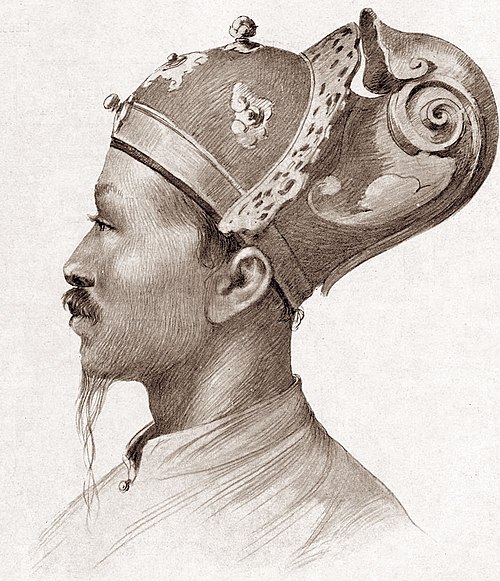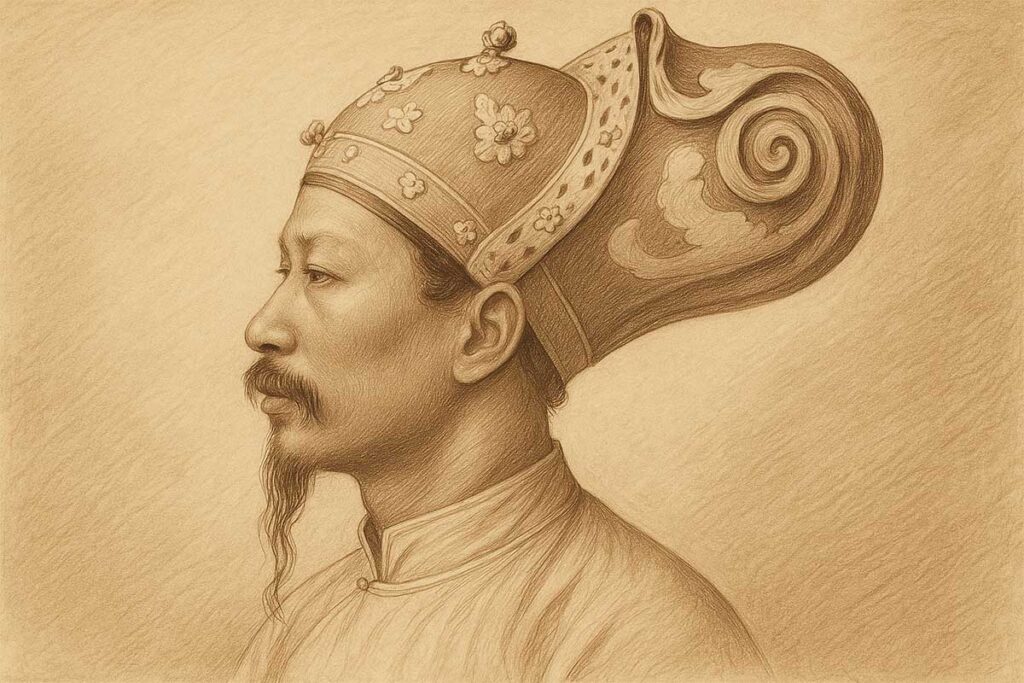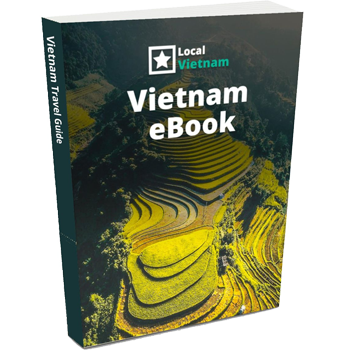Who was Tu Duc?
Born Nguyễn Phúc Hồng Nhậm in 1829, Emperor Tự Đức ruled Vietnam from 1847 until his death in 1883, making him the longest reigning monarch of the Nguyễn dynasty. He is remembered for his devotion to Confucian learning and poetry, leaving behind a large body of writings that show his intellectual and artistic side.

At the same time, his political choices were far less admired: he clung to isolationist policies, resisted reforms, and persecuted Christians, decisions that weakened Vietnam in the face of rising French power. This contrast—between the sensitive poet who sought harmony in words and the conservative emperor whose rule hastened colonial domination—makes Tự Đức one of Vietnam’s most complex and controversial figures.
Vietnam at the time of Tu Duc
When Tự Đức came to the throne in the mid-19th century, Vietnam was still a Confucian monarchy deeply rooted in tradition and wary of outside influence. The Nguyễn dynasty relied on a rigid system of mandarins and classical Chinese-style education, with rulers seeing themselves as guardians of morality and order rather than innovators. This worldview made the court suspicious of Western trade, technology, and religion, especially Catholicism, which was growing quickly through missionary work. At the same time, Vietnam was not an isolated island of stability—regional politics, from Qing China to Siam, constantly shaped its position in Southeast Asia.
Internally, the country was fragile. Famines, floods, and cholera epidemics devastated large parts of the population, while heavy taxation and corruption stirred unrest among peasants. Uprisings were frequent, and the monarchy often had to divert resources to suppress them. Externally, European colonial powers were expanding their reach in Asia, and France in particular had growing ambitions in Vietnam. Understanding this backdrop—of a kingdom clinging to tradition while facing crises at home and foreign pressure from abroad—helps explain why Tự Đức’s reign unfolded with so many conflicts and why his policies had such lasting consequences.
Key events in Tu Duc’s life
Early Life & Succession
Nguyễn Phúc Hồng Nhậm, later known as Tự Đức, was born in 1829 as the son of Emperor Thiệu Trị. Although he was not the eldest, he was chosen as successor because of his strong Confucian education and reputation for being scholarly and disciplined. His older brother, Hồng Bảo, was passed over, a decision that would later fuel family conflict and rebellion.
Conflicts with Hong Bao & Family Rebellions
The succession dispute created deep resentment. Hồng Bảo and his supporters plotted against Tự Đức but were discovered before they could act, leading to Hồng Bảo’s imprisonment and suicide. Later, Hồng Bảo’s sons attempted uprisings, which were crushed with harsh punishments, including executions. These family dramas highlighted the fragility of Nguyễn rule and kept Tự Đức on constant guard against internal threats.
Religious Suppression & Isolationism
Tự Đức’s reign is notorious for his hostility toward Christianity. He continued his predecessors’ persecution of Catholics, ordering executions and branding converts as heretics. At the same time, he refused to embrace modernization, ignoring repeated reform proposals from progressive mandarins like Nguyễn Trường Tộ, who urged the court to adopt Western science and education. This rigid conservatism left Vietnam increasingly vulnerable in an era when neighboring countries were beginning to modernize.
Natural Disasters & Famines
Nature added to the turmoil of his reign. Epidemics such as cholera killed hundreds of thousands, while cycles of droughts and floods led to widespread famine. These disasters fueled popular unrest and further weakened confidence in the monarchy’s ability to govern effectively.
Uprisings & Foreign threats
Beyond internal dissent, Tự Đức’s government struggled to control northern Vietnam (Tonkin), where Chinese rebel bands such as the White Flag and Yellow Flag armies crossed the border to raid towns and villages. The court eventually relied on the Black Flag Army, a mercenary force, to fight back. This dependence on outsiders underlined the declining strength of the Nguyễn military.
French Conquest & Loss of Southern Vietnam
The decisive blow came from abroad. In 1858, French and Spanish forces attacked from Đà Nẵng, and by 1862 Tự Đức was forced to sign the Treaty of Saigon, ceding three southern provinces (Cochinchina) to France. Later treaties in 1874 expanded French control, while Tự Đức tried to balance this humiliation by appealing to Qing China for protection. His resistance achieved little, and each concession chipped away at Vietnamese sovereignty.
Later Years & Death
By the late 1870s, Tự Đức’s authority was fading, and diplomacy was his main tool for survival. Stricken by smallpox earlier in life, he remained childless despite his large royal harem, and had to adopt heirs. He died in 1883, leaving Vietnam weakened, divided, and increasingly under French dominance. His adopted successor, Dục Đức, ruled for only three days before being deposed, marking the start of further instability.
Emperor Tu Duc in Vietnam today
Tomb of Tu Duc (Hue)

The main place where travelers encounter his legacy is at his Tu Duc tomb complex, just a few kilometers outside Hue. Spread across a pine-covered area with lakes, pavilions, and courtyards, the site reflects the emperor’s love for poetry and retreat from politics. It feels more like a landscaped park than a typical mausoleum, as Tự Đức himself designed it as both a place to rule and a retreat in life, not just a resting place in death.
For visitors, it’s one of Hue’s most atmospheric royal tombs—serene and scenic, though it can get crowded with tour groups at peak times. Among the tombs of the Nguyễn emperors, Tự Đức’s stands out for its size, complexity, and personal touch, making it a highlight for anyone exploring Hue’s imperial heritage.
Hue Citadel & Imperial City
Inside Hue’s Imperial City, Tự Đức’s reign is still visible through surviving inscriptions and the records he left behind. Although the complex suffered heavy damage during wars, you can still find traces of the era when Tự Đức governed from here. His focus on Confucian traditions and scholarship is reflected in the ceremonial halls and the way the court was organized, giving today’s visitors a sense of how rigidly structured the Nguyễn dynasty remained during his rule.
Literary legacy
Beyond monuments, Tự Đức is remembered as one of Vietnam’s most prolific poet-emperors. He left behind thousands of verses, many of which are inscribed in stone at his tomb and other sites around Hue. Even if you don’t read classical Chinese or Nôm script, you’ll see the calligraphy carved into pavilions and steles, showing how strongly he linked his identity as a ruler to his role as a scholar and writer.
Commemoration in modern Vietnam
Today, Tự Đức’s name still appears across Vietnam in more everyday contexts. Streets and schools bear his name, particularly in Hue, and students encounter him in textbooks as part of the country’s complex history with colonialism. While his political choices are often judged harshly, his cultural contributions ensure he remains a recognizable figure for modern Vietnamese—and a name foreign visitors will quickly encounter when exploring Hue’s historical landmarks.
Other famous emperors of Vietnam
Tự Đức’s long reign places him among Vietnam’s most notable rulers, but the country’s history is shaped by many other emperors and leaders whose legacies remain visible today. For travelers interested in Vietnam’s past, these figures provide a wider perspective on how the nation evolved across dynasties.
- Lý Thái Tổ (reigned 1009–1028) – Founder of the Lý dynasty who moved the capital to Hanoi (then Thăng Long), setting the stage for nearly a millennium of rule from the city.
- Trần Hưng Đạo (1228–1300) – A prince rather than an emperor, but celebrated as a national hero for leading Vietnam to victory over the Mongol invasions in the 13th century.
- Lê Lợi (reigned 1428–1433) – Leader of the Lam Sơn uprising against Ming China and founder of the Later Lê dynasty, remembered for restoring Vietnam’s independence.
- Gia Long (reigned 1802–1820) – First emperor of the Nguyễn dynasty, who reunified Vietnam after centuries of division and established Hue as the imperial capital.
- Minh Mạng (reigned 1820–1841) – Known as a reformer and empire builder, he strengthened central control and expanded the Nguyễn dynasty’s reach.
- Bảo Đại (reigned 1926–1945) – The last emperor of Vietnam, who abdicated in 1945 as Hồ Chí Minh declared independence, ending the monarchy altogether.



